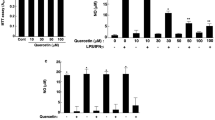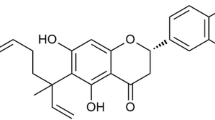Abstract
Quercetin is a flavonoid molecule ubiquitous in nature and functions as an anti-oxidant and anti-inflammatory agent with little toxicity in vivo and in vitro. Dose- and time-dependent effect of quercetin has been investigated on proinflammatory cytokine expression and NO production, focusing on its effects on the MAP kinases and the NF-κB signal transduction pathways in LPS-stimulated RAW 264.7 cells by using RT-PCR and immunoblotting. Quercetin strongly reduced activation of phosphorylated ERK kinase and p38 MAP kinase but not JNK MAP kinase by LPS treatment. In addition, quercetin treatment inhibited NF-κB activation through stabilization of the NF-κB/IκB complex and IκB degradation and proinflammatory cytokines and NO/iNOS expression. Quercetin may exert its anti-inflammatory and immunomodulatory properties in the effect molecules such as proinflammatory cytokines and NO/iNOS by suppressing the activation of ERK and p38 MAP kinase, and NF-κB/IκB signal transduction pathways.
Similar content being viewed by others
References
Anik ST, Frederic C, Pierre T, Yves SP, Albert D: Protein kinase C-α modulates LPS-induced functions in a murine macrophage cell line. J Biol Chem 273: 32787-32792, 1998
Baldassare JJ, Bi Y, Bellone CJ: The role of p38 mitogen-activated protein kinase in IL-1β transcription. J Immunol 162: 5367-5373, 1999
Wright SD, Ramos RA, Tobias PS, Ulevitch RJ, Mathison JC: CD14, a receptor for complexes of lipopolysaccharide (LPS) and LPS binding protein. Science 249: 1431-1433, 1990
Wang J, Mazza G: Inhibitory effects of anthocyanins and other phenolic compounds on nitric oxide production in LPS/IFN-γ-activated RAW 264.7 macrophages. J Agric Food Chem 50: 850-857, 2002
Tracey KJ, Cerami A: Tumor necrosis factor: A pleiotropic cytokine and therapeutic target. Annu Rev Med 45: 491-503, 1994
Cho KJ, Yun CH, Yoon DY, Cho YS, Rimbach G, Packer L, Chung AS: Effect of bioflavonoids extracted from the bark of Pins maritima on proinflammatory cytokine IL-1 production in LPS-stimulated RAW 264.7. Toxicol Appl Pharmacol 168: 64-71, 2000
Akira S, Taga T, Kishimoto T: Interleukin-6 in biology and medicine. Adv Immunol 54: 1-78, 1993
Nathan C, Xie QW: Nitric oxide synthases: Roles, tolls and controls. Cell 78: 915-918, 1994
Palmer RM, Ashton DS, Moncada S: Vascular endothelial cells synthesize nitric oxide from L-arginin. Nature (Lond) 333: 664-666, 1998
Hibbs JB, Taintor RR, Vavrin Z: Macrophage cytotoxicity: Role for L-arginin deaminase and imino nitrogen oxidation to nitrate. Science 235: 473-476, 1987
Chakravorty D, Kato Y, Sugiyama T, Koide N, Mu MM, Yoshida T, Yokochi T: Inhibition of caspase 3 abrogates LPS-induced NO production by preventing activation of NF-κB and JNK/SAPK in RAW 264.7 murine macrophage cells. Infect Immun 69: 1315-1321, 2001
Hambleton J, McMahon M, Defranco AL: Activation of Raf-1 and MAP kinase in murine macrophages partially mimics lipopolysaccharide-induced signaling events. J Exp Med 182: 147-154, 1995
Ralder-Pohl A, Sachsenmaier C, Gebel S, Auer HP, Bruder JT, Rapp U, Ahgel P, Rahmsdorf HJ, Herrlich P: UV-induced activation of AP-1 involves obligatory extranuclear steps including Raf-1 kinase. EMBO J 12: 1005-1012, 1993
Lohrer P, Gloddek J, Nagashima AC, Korali Z, Hopfner U, Pereda MP, Arzt E, Stalla GK, Renner U: LPS directly stimulates the intrapituitary IL-6 production by folliculostellate cells via specific receptors and the p38α MAPK/NF-κB pathway. Endocrinology 141: 4457-4465, 2000
Aramaki Y, Matsuno R, Tsuchiya S: Involvement of p38 MAP kinase in the inhibitory effects of phosphatidylserine liposomes on NO production form macrophages stimulated with LPS. Biochem Biophys Res Commun 280: 982-987, 2001
Hoare GS, Marczin N, Chester AH, Yacoub MH: Role of oxidant stress in cytokine-induced activation of NF-κB in human aortic smooth muscle cells. Am J Physiol 277: 1975-1984, 1999
Angeliki X, Andreas P, Antinis M, Michalis E, Theodore F, Charis R: Luteolin inhibits an endotoxin-stimulated phosphorylation cascade and proinflammatory cytokine production in macrophages. J Pharmacol Exp Ther 296: 181-187, 2001
Pan MH, Shiau SY, Lin JK: Comparative studies on the suppression of NO synthase by curcumin and its hydrogenated metabolites through down-regulation of IκB kinase and NF-κB activation in macrophages. Biochem Pharmacol 60: 1665-1676, 2000
Yoshihisa I, Kitamura M: Bioflavonoid quercetin inhibit mitosis and apoptosis of glomerular cells in vitro and vivo. Biochem Biophys Res Commun 297: 629-634, 2000
Kawada N, Seki S, Inoue M, Kuroki T: Effect of antioxidants, resversatol, quercetin, and n-actetylcysteine, on the functions of cultured rat hepatic stellate cells and Kupper cells. Hepatology 27: 1256-1274, 1998
Kasai K, Hattori Y, Nakanishi N, Manaka K, Banba N, Motohashi S, Shimoda S: Regulation of inducible nitric oxide production by cytokines in human thyrocytes in culture. Endocrinology 136: 4261-4270, 1995
Kobuchi H, Droy-Lefaix MT, Christen Y, Packer L: Ginko biloba extract (Egb 761): Inhibitory effect on nitric oxide production in the macrophage cell line RAW 264.7. Biochem Pharmacol 53: 897-903, 1997
Hagiwara M, Inoue S, Tanada T, Nunoki K, Ito M, Hidaka H: Differential effects of flavonoids as inhibitors of tyrosine protein kinase and serine/threonine protein kinases. Biochem Pharmacol 37:2987-2992, 1998
Csokay B, Prajda N, Weber G, Olah E: Molecular mechanisms in the antiproliferative action of quercetin. Life Sci 60: 2157-2163, 1997
Ruetten H, Thiemermann C: Effects of tryphostins and genistein on the circulatory failure and organ dysfunction caused by endotoxin in the rat: A possible role for protein tyrosine kinase. Br J Pharmacol 122: 59-70, 1997
Krol W, Cruba ZP, Threadgill MD, Cunningham BD, Pietse G: Inhibition of nitric oxide production in murine macrophages by flavones. Biochem Pharmacol 50: 1031-1035, 1995
Sadowska KH, Mannick EE, Oliver PD, Sandoval M, Zhang XJ, Eloby CS, Clark DA, Miller MJS: Genistein and gut inflammation: Role of nitric oxide. Proc Soc Exp Biol Med 217: 351-357, 1998
Yokoo T, Kitamura M: Unexpected protection of glomerular mesangial cells from oxidant-triggered apoptosis by bioflavonoid quercetin. Am J Physiol 273: 206-212, 1997
Davis RJ: Transcriptional regulation by MAP kinase. Mol Reprod Dev 42: 459-472, 1995
Lee JC, Young PR: Role of CSBP/p38/RK stress response kinase in LPS and cytokine signaling mechanisms. J Leuk Biol 59: 152-157, 1996
Joseph JB, Yanhua B, Clifford JB: The role of p38 mitogen-activated protein kinase in IL-1β transcription. J Immunol 162: 5367-5373, 1999
Dong Z, Qi X, Fidler IJ: Protein tyrosine kinase inhibitors decrease induction of nitric oxide synthase activity in lipopolysaccharide-responsive and lipopolysaccharide-nonresponsive murine macrophages. J Immunol 151: 2717-2724, 1993
Wei Z, Jocelyn SD, Jun G, Franco DP, Hermann G, Jiahuai H: Regulation of TNF expression by multiple mitogen-activated protein kinase pathway. J Immunol 163: 6349-6358, 2000
Beyaert R, Cuenda A, Vanden BW, Plaisance S, Lee JC, Haegeman G, Cohen P, Fiers W: The p38/RK mitogen-activated protein kinase pathway regulates interleukin-6 synthesis response to tumor necrosis factor. EMBO J 15: 1914-1923, 1996
Foey AD, Parry SL, Williams LM, Feldmann M, Foxwell BM, Brennan FM: Regulation of monocyte IL-10 synthesis by endogenous IL-1 and TNF-α: Role of the p38 and p42/44 mitogen-activated protein kinases. J Immunol 160: 920-928, 1998
Annabel FV, Monica C, Jordi X, Antonio C: The differential time-course of ERK activity correlates with macrophage response toward proliferation or activation. J Biol Chem 275: 7403-7409, 2000
Young P, McDonnell P, Dunnington D, Hand A, Laydon J, Lee J: Pyridnyl imidazoles inhibit IL-1 and TNF production at the protein level. Agent Action 39: C67-C69, 1993
Prichett W, Hand A, Sheilds J, Dunnington D: Mechanism of action of bicyclic imidazoles defines a translational regulatory pathway for tumor necrosis factor α. J Inflamm 45: 97-105, 1995
Teri LW, Dennis RK: Effect of the wine polyphenolics quercetin and resversatol on proinflammatory cytokine expression in RAW 264.7 macrophage. Biochem Pharmacol 57: 941-949, 1999
Yang F, Villiers WJ, McClain CJ, Varilek GW: Green tea polyphenols block endotoxin-induced tumor necrosis factor-production and lethality in a murine model. J Nutr 128: 2334-2340, 1998
Author information
Authors and Affiliations
Rights and permissions
About this article
Cite this article
Cho, SY., Park, SJ., Kwon, MJ. et al. Quercetin suppresses proinflammatory cytokines production through MAP kinases and NF-κB pathway in lipopolysaccharide-stimulated macrophage. Mol Cell Biochem 243, 153–160 (2003). https://doi.org/10.1023/A:1021624520740
Issue Date:
DOI: https://doi.org/10.1023/A:1021624520740




